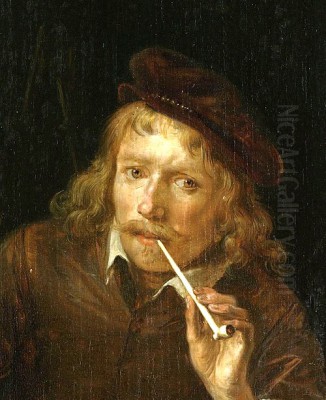
Gerrit Dou stands as a pivotal figure in the rich tapestry of Dutch Golden Age painting. Born in Leiden in 1613 and passing away in the same city in 1675, his life spanned a period of extraordinary artistic flourishing in the Netherlands. Dou is celebrated not merely as a painter of remarkable skill, but as the founder and leading exponent of the Leiden school of "fijnschilders," or "fine painters," renowned for their exquisitely detailed execution and polished surfaces. His meticulous technique, mastery of light, and intimate portrayals of everyday life secured him immense fame during his lifetime and a lasting legacy in the annals of art history.
Early Life and the Rembrandt Apprenticeship
Gerrit Dou's artistic journey began under the influence of his father, Douwe Jansz., a skilled glass engraver and glazier in Leiden. This early exposure to detailed craftsmanship likely laid the foundation for the meticulousness that would define his later painting style. He received initial training in drawing and glasswork before making a decisive move that would shape his career: in February 1628, at the age of fourteen, he entered the Leiden studio of the young but already promising Rembrandt van Rijn.
Dou became Rembrandt's first documented pupil, studying under the master for approximately three years, until Rembrandt relocated to Amsterdam around 1631 or 1632. This period was crucial for Dou's development. He absorbed Rembrandt's early Leiden style, characterized by strong chiaroscuro (contrasts of light and dark), expressive figures, an interest in character studies (often featuring elderly subjects), and the use of impasto (thickly applied paint) to create texture. Dou learned composition, the dramatic handling of light, and the depiction of various materials and surfaces from his teacher.
The Rembrandt Connection and Early Works
The influence of Rembrandt is palpable in Dou's works from the late 1620s and early 1630s. Paintings from this period often share subjects and stylistic approaches with his master. Works like Rembrandt's Mother (a title given to portraits of elderly women resembling Rembrandt's mother, Neeltgen Willemsdr. van Zuytbroeck) demonstrate this close connection, employing the dramatic lighting and psychological intensity favoured by Rembrandt.
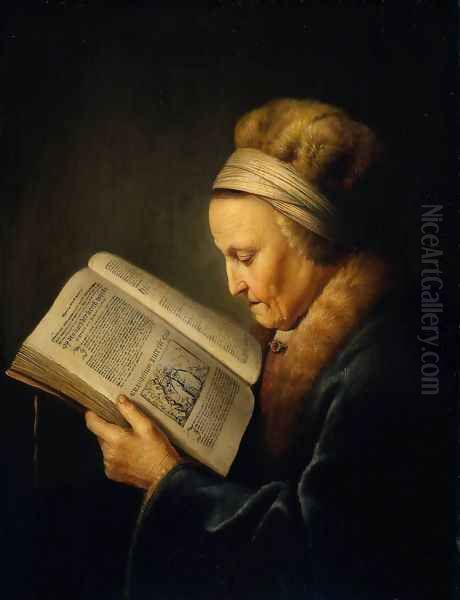
Indeed, the stylistic similarity was sometimes so pronounced that attribution issues have arisen. Certain paintings, such as the work sometimes titled Self-Portrait (?) at an Easel, have historically been debated, shifting between attributions to Rembrandt and Dou. This highlights the depth of Rembrandt's initial impact on his pupil and Dou's rapid assimilation of his master's techniques. However, even in these early years, hints of Dou's own meticulous tendencies began to emerge.
Forging an Independent Path: The Fijnschilder Style
When Rembrandt departed for the bustling art market of Amsterdam, Gerrit Dou chose to remain in his native Leiden. This decision marked the beginning of his independent career and the point where he began to diverge significantly from Rembrandt's evolving style. While Rembrandt moved towards broader, more expressive brushwork and deeper psychological explorations, Dou cultivated an entirely different aesthetic: the fijnschilder or "fine painter" style.
This style became synonymous with Leiden painting in the mid-17th century, and Dou was its undisputed pioneer and leader. The fijnschilder approach emphasized meticulous detail, a highly polished finish often described as enamel-like, and the illusionistic rendering of textures and surfaces. Dou worked on a small scale, typically using wood panels rather than canvas to achieve the smoothest possible ground for his intricate work.
His working methods were famously painstaking. Contemporaries reported that he used magnifying glasses to render minute details, ground his own pigments to ensure the finest quality, and employed exceptionally fine brushes. Anecdotes survive describing him spending days on seemingly minor elements – three days perfecting a tiny broom in one painting, five days devoted solely to the background behind a hand in a portrait. He was known to protect his studio meticulously from dust, fearing even the smallest speck might mar the pristine surface of his work-in-progress.
Themes and Subjects: Intimate Worlds
Gerrit Dou's subject matter primarily revolved around genre scenes, portraits, and still lifes, often combined within a single composition. He excelled at depicting intimate interior scenes, offering glimpses into the domestic lives, scholarly pursuits, and small trades of Leiden's citizens. Kitchen maids, doctors attending patients, scholars in their studies, musicians, astronomers, herring sellers, poulterers, and dentists populate his canvases.
Unlike some contemporaries such as Jan Steen, who often depicted boisterous or chaotic scenes, Dou's interiors are typically calm, ordered, and feature only a few figures. He often focused on moments of quiet concentration or simple domestic activity. Works like The Dutch Cook or The Young Mother exemplify this focus, presenting idealized yet detailed visions of household life. The objects within these scenes – copper pots, earthenware jugs, baskets, textiles – are rendered with astonishing fidelity.
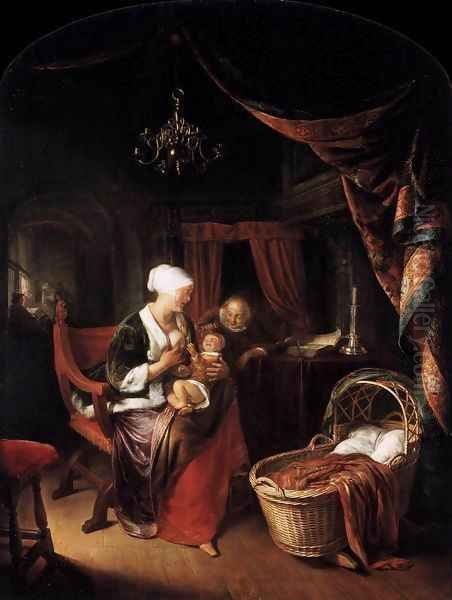
Beyond mere representation, Dou often imbued his scenes with symbolic or moralizing undertones, a common practice in Dutch Golden Age art. Objects could carry hidden meanings. For instance, in A Hermit in Prayer, elements like a skull, an hourglass, or an extinguished lamp serve as vanitas symbols, reminding the viewer of the transience of life and the importance of spiritual contemplation. Similarly, depictions of scholars might allude to the pursuit of knowledge, while scenes involving doctors could touch upon themes of health, mortality, and sometimes even amorous subtexts, as suggested by the analysis of works like The Physician.
Mastery of Light and Composition
A defining characteristic of Dou's art is his exceptional handling of light and shadow. Building on the chiaroscuro learned from Rembrandt, he developed a refined technique perfectly suited to his detailed style. He was particularly adept at rendering artificial light sources, creating captivating candlelit or lantern-lit night scenes. The interplay of light across different surfaces – the gleam on metal, the softness of velvet, the translucency of glass – is rendered with virtuosity.
Dou frequently employed natural light streaming through windows to illuminate his interiors, using it to model forms, create atmosphere, and draw the viewer's eye to specific details. This careful orchestration of light adds depth and intimacy to his small-scale works, making the depicted spaces feel tangible and inviting.
Compositionally, Dou is famous for popularizing the "niche picture" or "window frame" motif. In many of his paintings, the scene is presented as if viewed through an arched stone window or doorway, often complete with a sill on which objects might rest. Sometimes, a curtain is depicted hanging across part of the opening, further enhancing the illusion of looking into a private space. This framing device, a form of trompe-l'oeil ("deceive the eye"), cleverly plays with the boundary between the viewer's world and the painted world, enhancing the sense of realism and voyeuristic intimacy. Girl at a Window and The Physician are excellent examples of this compositional strategy.
Key Representative Works
Several paintings stand out as quintessential examples of Gerrit Dou's artistry:
The Trumpeter (Le Jeu de trompette): Housed in the Louvre, this work showcases Dou's skill in rendering complex scenes with multiple figures and rich detail, likely within the characteristic niche format.
The Dutch Cook (La Cuisinière hollandaise): Also in the Louvre, this painting is a prime example of his domestic genre scenes, celebrated for its meticulous depiction of kitchen utensils and textures, bathed in subtle light.
The Poulterer's Shop: This subject, which Dou painted multiple times, allowed him to display his incredible skill in rendering textures – feathers, flesh, baskets, and various market goods – often framed within the signature window setting.
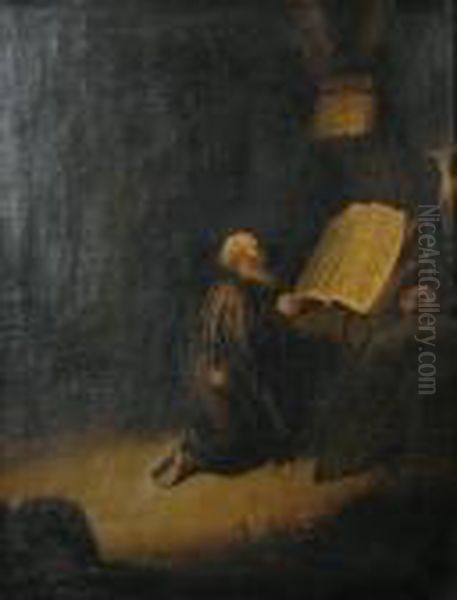
The Physician: Held in the Kunsthistorisches Museum, Vienna, this work is noted not only for its technical brilliance and use of the niche frame but also for its potential symbolic content related to medicine and perhaps love sickness.
The Young Mother: Located in the Royal Collection, UK (on loan to the Mauritshuis), this tender scene exemplifies Dou's ability to capture quiet domesticity and familial bonds with exquisite detail and sensitive lighting.
Scholar Sharpening His Quill: In the Rijksmuseum, Amsterdam, this painting represents another favourite theme – the contemplative world of the scholar, surrounded by books and instruments, rendered with Dou's typical precision.
The Mousetrap: Housed in the Musée Fabre, Montpellier, this work likely combines genre elements with potential symbolic meanings, executed with Dou's characteristic finesse.
These works, among many others, demonstrate the core tenets of Dou's style: unparalleled detail, smooth finish, masterful light effects, intimate subjects, and often ingenious compositional framing.
The Leiden School and Dou's Students
Gerrit Dou's influence extended far beyond his own canvases. As the leading proponent of the fijnschilder style, he became the central figure of the Leiden School of painting. His success attracted numerous pupils eager to learn his meticulous techniques. He ran a successful workshop and trained several artists who went on to achieve considerable fame in their own right.
Among his most notable students were Frans van Mieris the Elder, who perhaps came closest to matching Dou's own refinement and detail; Gabriel Metsu, who adopted the fine painting style but often applied it to slightly more elegant or socially nuanced scenes; Godfried Schalcken, known particularly for his mastery of candlelit scenes, clearly inspired by Dou; and the less famous Meindert van der Stel. These artists, along with others influenced by Dou, solidified Leiden's reputation as a centre for highly detailed, cabinet-sized paintings that were immensely popular with collectors. The legacy of the Leiden fijnschilders is inextricably linked to Dou's foundational role.
Contemporary Reputation, Patronage, and Influence
During his lifetime, Gerrit Dou enjoyed enormous success and international renown. His paintings commanded exceptionally high prices, often fetching sums far greater than those achieved by his former teacher Rembrandt or contemporaries like Johannes Vermeer or Pieter de Hooch. His meticulous finish and jewel-like quality appealed greatly to wealthy Dutch burghers and aristocratic collectors across Europe.
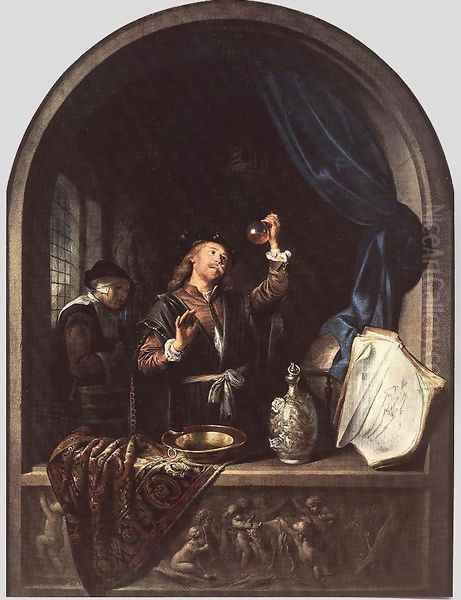
He secured important patronage, notably from Pieter Spiering Silvercrona, the agent of Queen Christina of Sweden residing in The Hague, who paid Dou an annual retainer for the right of first refusal on his new works. His paintings were considered prestigious possessions. In 1660, the Dutch States presented a collection of paintings to King Charles II of England upon his restoration, which included a work by Dou, signifying his high status. His fame was such that Archduke Leopold Wilhelm of Austria and Cosimo III de' Medici, Grand Duke of Tuscany, also visited his studio or acquired his works.
Dou's influence can be seen not only in his direct pupils but also in the broader trends of Dutch genre painting. While artists like Vermeer developed their own unique styles, the shared interest in intimate interiors, the effects of light, and careful composition suggests a dialogue with the prevailing tastes shaped partly by Dou's success. Even artists working in different genres, like the still life painter Willem van Aelst, shared the commitment to detailed rendering and illusionistic surfaces characteristic of the fijnschilder aesthetic.
Legacy and Major Collections
Gerrit Dou remained in Leiden throughout his life, never marrying, and died there in 1675. While the taste for highly detailed painting waned somewhat with the rise of broader styles in the 18th century and later with Impressionism, Dou's reputation as a master technician never entirely faded. In the 20th and 21st centuries, his work has been the subject of renewed scholarly interest and major exhibitions, such as the one held at the National Gallery of Art in Washington D.C. in 2000.
Today, Gerrit Dou's paintings are prized possessions of major museums around the world. Significant holdings can be found at:
The Louvre Museum, Paris
The Rijksmuseum, Amsterdam
The Mauritshuis, The Hague
The National Gallery, London
The Dulwich Picture Gallery, London
The Royal Collection Trust, UK
The Leiden Collection, New York
The Metropolitan Museum of Art, New York
The National Gallery of Art, Washington D.C.
The Kunsthistorisches Museum, Vienna
The Gemäldegalerie Alte Meister, Dresden
The Musée Fabre, Montpellier
The Clark Art Institute, Williamstown, Massachusetts
His works also appear in numerous other public and private collections, including historically significant ones like that of Salvador Dalí, attesting to his enduring appeal across centuries.
Conclusion: The Enduring Master of Detail
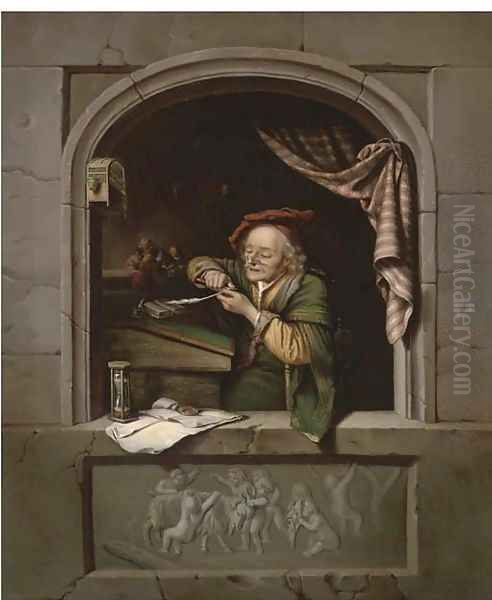
Gerrit Dou occupies a unique and significant place in Dutch art history. As Rembrandt's first pupil, he absorbed the foundational techniques of the Dutch Baroque. Yet, he forged his own distinct path, becoming the father of the Leiden fijnschilder movement and setting a standard for meticulous craftsmanship and illusionistic detail that few could rival. His intimate portrayals of 17th-century Dutch life, rendered with unparalleled precision and a masterful command of light, captivated audiences in his own time and continue to fascinate viewers today. Dou's legacy lies not only in his beautiful, jewel-like paintings but also in his profound influence on a generation of artists who followed his lead in celebrating the beauty found in the careful observation and exquisite rendering of the everyday world.